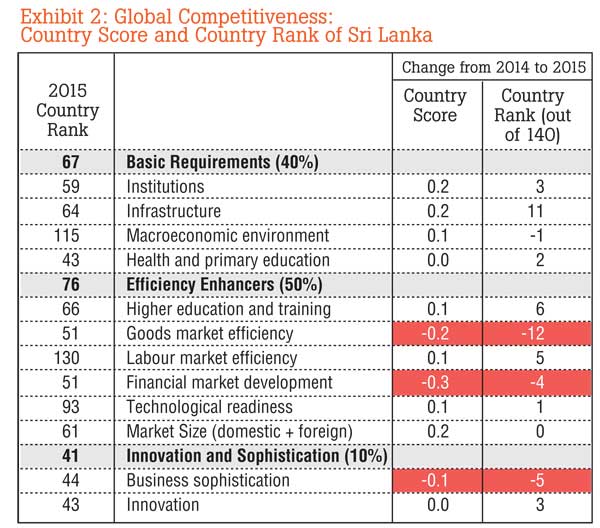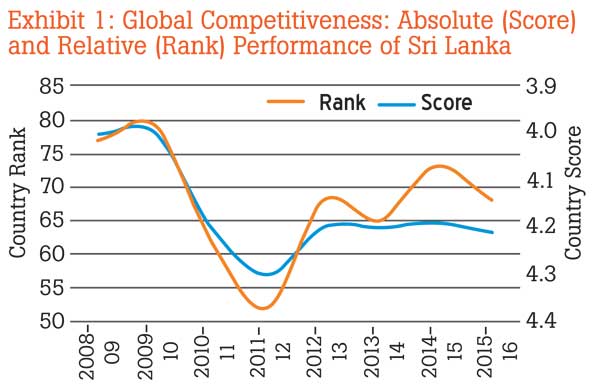.jpg)
.jpg)
The Global Competitiveness Index of the World Economic Forum defines competitiveness as “the set of institutions, policies and factors that determine the level of productivity of a country”. The productivity of a country in turn determines its ability to sustain a high level of income.
The 2015 Global Competitiveness Report (GCR) released at the end of September shows that Sri Lanka is ranked 68 out of 140 countries. Compared to last year, Sri Lanka has improved its ranking by five places. This article provides two simple insights into the ranking of Sri Lanka in the GCR. First is that despite improvement in its ranking, the country has hardly seen improvements in its overall competitiveness score, and second, the overall competitiveness score has hardly increased because the improvements in basic structural areas are being offset by the declines in critical areas that drive the efficiency of the economy.

Competitiveness scoring and ranking
The GCR gives a country a score on its performance and ranks the country against others based on the score. The score (1-7) provides an assessment of the country’s own or absolute performance and the rank provides an assessment of the country’s relative performance against other countries. Relative performance can improve or decline even without any improvement or decline in the score. This is because changes in the scores of other countries and addition or removal of countries evaluated affect the ranking.
In terms of score, a higher score reflects better performance. In terms of rank, the best performer is ranked 1 and the worst 140.
Backsliding after post-war bump up
Exhibit 1 shows that with the end of the conflict, Sri Lanka has seen both improvements in its ranking and score. The rank improved from 79 in 2009 to 52 in 2012. In the same period, the score improved from 4.0 to 4.3.
2012 was as good as it got. Since then Sri Lanka’s rank slid down to73 in 2014— its lowest —and remains at a backslidden 68. Yet, this is a significant improvement from the rank of 79 in 2009. However, the score does not reflect much gain. The score was 4.3 in 2009, and despite the post-war improvement, has since dropped back to around 4.2.
The improvement in the rankings is positive because competitiveness is ultimately a matter of relative standing. However, the absolute score reflects fundamental aspects of the country’s functioning. The total improvement in the score in the space of six years, since 2009, is less than 3 percent - hardly any improvement at all.

Efficiency losses have offset basic improvements
The lack of notable improvement in the overall score deserves further investigation. The GCR measures competitiveness using 10 indicators, falling under three broad categories (Exhibit 2). The first category includes basic structural aspects, the second the mid-level aspects that drive efficiency and third are the advanced aspects that drive innovation and creativity. Sri Lanka’s score has stagnated because while there have been improvements in the basic structural aspects, there have also been declines in the aspects that drive efficiency (see Exhibit 2).
For example, as a result of the heavy investments Sri Lanka made in infrastructure, the score in this indicator has improved by 0.2 between 2014 and 2015, and this has led to an improvement of the rank by 11 places in that particular indicator. This gain, however, has been offset with Sri Lanka doing poorly in terms of goods market efficiency, where a loss of 0.2 in the score has led the country to lose 12 places in the rank of that indicator (Exhibit 2). The goods market efficiency has declined over the year because the number of procedures and days to start a business has in fact increased, and the level of trade tariffs (many of them imposed in an ad hoc manner) has also increased.
Likewise, the gains in score of 0.2 and 0.1, respectively in the basic structural areas of institutions and macroeconomic environment are offset by a 0.3 decline in financial market development, which is an area that drives efficiency. The decline here is connected to the weakening of the banking sector and deficiencies in the area of legal protection.
As a country grows in per capita income, the drivers of competitive success shift away from basic structural aspects towards factors that drive the efficiency of the economy. The GCR takes this into account and gives greater weight to the efficiency factors as the per capita income increases. Sri Lanka has made progress in the post-war challenge of consolidating its basic economic structures. The challenge ahead is to arrest and reverse the decline in the aspects of the economy that drive efficiency and innovation.
(Verité Research is an independent think-tank based in Colombo that provides strategic analysis to high level decision-makers in economics, law, politics and media. Comments are welcome. Email [email protected])
.jpg)
.jpg)

